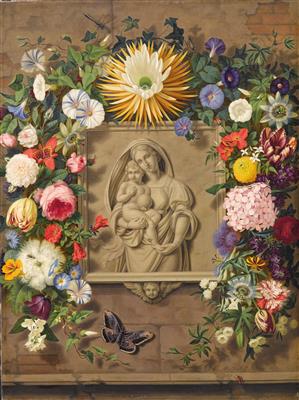Carl Adolf Senff

(Halle 1785–1863 Ostrau)
Madonna with Child Wreathed in Flowers, signed, inscribed, dated Adolfo Senff Roma 1839, oil on canvas, 100 x 76 cm, framed, (GG)
Adolf Senff started out as a theologian in Leipzig, before working as a private tutor to the children and students of painter Gerhard von Kügelgens (1772– 1820). Although he was already active as a painter and portraitist in Leipzig from 1813–14, it was only after the war on France, for which he volunteered, that he truly dedicated himself to the arts. He lived in Rome between 1816 and 1848 where he befriended the famous sculptor Bertel Thorvaldsen (1770–1844). Senff mainly executed copies of Rafael and still lifes with flowers; a style in which he excelled, to the extent that his contemporaries assigned him the moniker Flower Rafael. Not only is the depiction of the flora in the present work stunningly precise, their selection has also been most thorough.
His decision to adorn a depiction of Mary and her son with bindweed, is a deliberate one; in German-speaking regions these flowers are referred to as ‘Mother of God’s little glasses’. This is also the title of a tale by the Brothers Grimm inspired by German folklore: thirsty and at the side of a road, the Virgin Mary asks a peasant for water. Not having a glass to offer her, he pours it into a bindweed flower from which the Virgin Mary then drinks. The passion flowers Senff painted are also known as ‘Mother of God stars’. Since their discovery by Christian missionaries, these flowers have always been associated with the Passion of Christ: the 10 petals represent the apostles who stayed true to Jesus, the tendrils recall the whip used in the flagellation of the Christ, while the 3 stigmas and 5 anthers are symbols of the nails used to crucify Jesus and his wounds.
We also see jasmine, an allegory of godly love, and roses, a mystical symbol for the Virgin Mary. The butterfly evokes the resurrection of Jesus Christ. This painting is not only a strikingly beautiful and tender representation of the Virgin Mary, gently holding her son’s feet and with her head resting on his, it is also an intelligent devotional image which encourages us to reflect on the Bible.
Esperto: Gautier Gendebien
 Gautier Gendebien
Gautier Gendebien
+39-334-777 1603
Gautier.Gendebien@dorotheum.it
23.04.2015 - 18:00
- Stima:
-
EUR 15.000,- a EUR 20.000,-
Carl Adolf Senff
(Halle 1785–1863 Ostrau)
Madonna with Child Wreathed in Flowers, signed, inscribed, dated Adolfo Senff Roma 1839, oil on canvas, 100 x 76 cm, framed, (GG)
Adolf Senff started out as a theologian in Leipzig, before working as a private tutor to the children and students of painter Gerhard von Kügelgens (1772– 1820). Although he was already active as a painter and portraitist in Leipzig from 1813–14, it was only after the war on France, for which he volunteered, that he truly dedicated himself to the arts. He lived in Rome between 1816 and 1848 where he befriended the famous sculptor Bertel Thorvaldsen (1770–1844). Senff mainly executed copies of Rafael and still lifes with flowers; a style in which he excelled, to the extent that his contemporaries assigned him the moniker Flower Rafael. Not only is the depiction of the flora in the present work stunningly precise, their selection has also been most thorough.
His decision to adorn a depiction of Mary and her son with bindweed, is a deliberate one; in German-speaking regions these flowers are referred to as ‘Mother of God’s little glasses’. This is also the title of a tale by the Brothers Grimm inspired by German folklore: thirsty and at the side of a road, the Virgin Mary asks a peasant for water. Not having a glass to offer her, he pours it into a bindweed flower from which the Virgin Mary then drinks. The passion flowers Senff painted are also known as ‘Mother of God stars’. Since their discovery by Christian missionaries, these flowers have always been associated with the Passion of Christ: the 10 petals represent the apostles who stayed true to Jesus, the tendrils recall the whip used in the flagellation of the Christ, while the 3 stigmas and 5 anthers are symbols of the nails used to crucify Jesus and his wounds.
We also see jasmine, an allegory of godly love, and roses, a mystical symbol for the Virgin Mary. The butterfly evokes the resurrection of Jesus Christ. This painting is not only a strikingly beautiful and tender representation of the Virgin Mary, gently holding her son’s feet and with her head resting on his, it is also an intelligent devotional image which encourages us to reflect on the Bible.
Esperto: Gautier Gendebien
 Gautier Gendebien
Gautier Gendebien
+39-334-777 1603
Gautier.Gendebien@dorotheum.it
|
Hotline dell'acquirente
lun-ven: 10.00 - 17.00
kundendienst@dorotheum.at +43 1 515 60 200 |
| Asta: | Dipinti del XIX secolo |
| Tipo d'asta: | Asta in sala |
| Data: | 23.04.2015 - 18:00 |
| Luogo dell'asta: | Wien | Palais Dorotheum |
| Esposizione: | 11.04. - 23.04.2015 |
